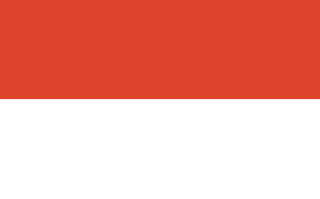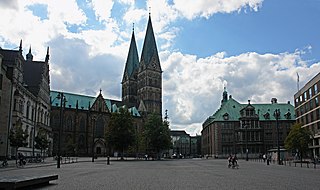
The Duchy of Carinthia was a duchy located in southern Austria and parts of northern Slovenia. It was separated from the Duchy of Bavaria in 976, and was the first newly created Imperial State after the original German stem duchies.

Bremen, officially the Free Hanseatic City of Bremen, is the smallest and least populous of Germany's 16 states. It is informally called Land Bremen, although the term is sometimes used in official contexts. The state consists of the city of Bremen and its seaport exclave, Bremerhaven, surrounded by the larger state of Lower Saxony in northern Germany.

The Prince-Archbishopric of Bremen — not to be confused with the modern Archdiocese of Hamburg, founded in 1994 — was an ecclesiastical principality (787–1566/1648) of the Holy Roman Empire and the Catholic Church that after its definitive secularization in 1648 became the hereditary Duchy of Bremen. The prince-archbishopric, which was under the secular rule of the archbishop, consisted of about a third of the diocesan territory. The city of Bremen was de facto and de jure not part of the prince-archbishopric. Most of the prince-archbishopric lay rather in the area to the north of the city of Bremen, between the Weser and Elbe rivers. Even more confusingly, parts of the prince-archbishopric belonged in religious respect to the neighbouring Diocese of Verden, making up 10% of its diocesan territory.

Stade, officially the Hanseatic City of Stade is a city in Lower Saxony in northern Germany. First mentioned in records in 934, it is the seat of the district which bears its name. It is located roughly 45 km (28 mi) to the west of Hamburg and belongs to that city's wider metropolitan region. Within the area of the city are the urban districts of Bützfleth, Hagen, Haddorf and Wiepenkathen, each of which have a council of their own with some autonomous decision-making rights.

Vegesack is a northern district of Bremen, the capital of the German state Free Hanseatic City of Bremen.

Bremer Vulkan AG was a prominent German shipbuilding company located at the Weser river in Bremen-Vegesack. It was founded in 1893 and closed in 1997 because of financial problems and mismanagement.

Bremen Cathedral, named after St. Peter, is a church situated in the market square in the center of Bremen. The cathedral belongs to the Bremian Evangelical Church, a member of the umbrella organization Protestant Church in Germany. It is the previous cathedral of the former Prince-Archbishopric of Bremen. Since 1973, it is protected by the monument protection act.

For most of its 1,200 year history, Bremen was an independent city within the confederal jurisdiction of the Holy Roman Empire. In the late Middle Ages, its governing merchant guilds were at the centre of the Hanseatic League, which sought to monopolise the North Sea and Baltic trade. To establish and confirm its independence, the city had to contend first with the Prince-Archbishop of Bremen, and then with the Swedes, who had become the masters of the surrounding, former episcopal, duchies after the Thirty Years' War.

The State Parliament of Bremen is the legislative branch of the Free Hanseatic City of Bremen in Germany. The state parliament elects the members of the Senate (executive), exercises oversight of the executive, and passes legislation. It currently consists of 87 members from six parties. The current majority is a coalition of the Social Democratic Party, Alliance 90/The Greens and The Left, supporting Mayor and Senate president Andreas Bovenschulte. The 72 delegates of the city of Bremen also form the Stadtbürgerschaft, while Bremerhaven has its own local parliament.

The Bremen tramway network is a network of tramways forming part of the public transport system in Bremen, Germany. The network is currently operated by Bremer Straßenbahn AG, and integrated in the Verkehrsverbund Bremen/Niedersachsen. As of 2024, the network had eight lines, extending over 114.6 kilometres (71.2 mi) of route. Several sections have been brought to light rail standard, including viaducts, especially on the lines to Osterholz, Arsten and Huchting. These rapid tram lines are also referred to as semi-metro.

The Swedish wars on Bremen were fought between the Swedish Empire and the Hanseatic town of Bremen in 1654 and 1666. Bremen claimed to be subject to the Holy Roman Emperor, maintaining Imperial immediacy, while Sweden claimed Bremen to be a mediatised part of her dominions of Bremen-Verden, themselves territories immediately beneath the emperor. Sweden was able to gain some territory, but despite forcing a formal oath of allegiance on Bremen, did not gain control of the town.

The Bremer Marktplatz is a square situated in the centre of the Hanseatic City of Bremen. One of the oldest public squares in the city, it covers an area of 3,484 m2 (37,500 sq ft). It is no longer used as a market place except for the Christmas market and the annual Freimarkt Fair at the end of October.
The following is a timeline of the history of the city of Bremen, Germany.

The Domshof is a town square in Bremen, north of the cathedral and the Marktplatz. The Domshof is used for markets as well as larger outdoor events, particularly May Day demonstrations.

The Bremen Cotton Exchange was built in 1902 on the market square in Bremen, Germany, to house the offices of the city's cotton exchange founded in 1872. Johann Poppe's Neo-Renaissance facades and carefully finished interiors can still be seen today.

The Ports of Bremen, Bremen Ports or Bremish Ports, in German "Bremische Häfen" consist of the commercial ports in Bremen and Bremerhaven. They are managed by bremenports GmbH & Co. KG, a company of private status in public property.

Unser Lieben Frauen Kirchhof is a central square in Bremen between the Bremer Marktplatz, Obernstraße, Sögestraße and the Domshof. The square is used as a flower market. The appearance of the square is quite consistent: sandstone, dark brick and clinker brick.

The Stedinger Crusade (1233–1234) was a Papally sanctioned war against the rebellious peasants of Stedingen.
The Punkendeich was a dike (floodbank) between the river Weser and the city of Bremen that was known for prostitution. It ran from the city wall (Altenwall) to Sielwall. Originally called the Sieldeich, the Punkendeich was incorporated into the larger Osterdeich in 1850. A road and houses were built along the top of the dike, the road later becoming part of the Osterdeich trunk road.

Franz Ernst Schütte was a German entrepreneur-businessman who during his lifetime became celebrated for the extent of his wealth. Although his business activities extended across several different sectors, including shipbuilding and land reclamation-development, it was on account of his oil importing activities, which included the establishment of the "Deutsch-Amerikanische Petroleum Gesellschaft" in 1890, that Schütte acquired the popular soubriquet "The Petroleum King". In his home city Schütte is also remembered as a massively effective Bremen benefactor, both through his own donations and through his effectiveness as a fund raiser among fellow members of the city's business elite, during what was a period of unprecedented commercial expansion. The city owes its "new" city hall and its Botanical Gardens to his philanthropy, along with the rebuilding between 1888 and 1901 of the west end of Bremen Cathedral in the confident "Gothic revival" style favoured for prestigious public buildings in central and western Europe during this period.



















